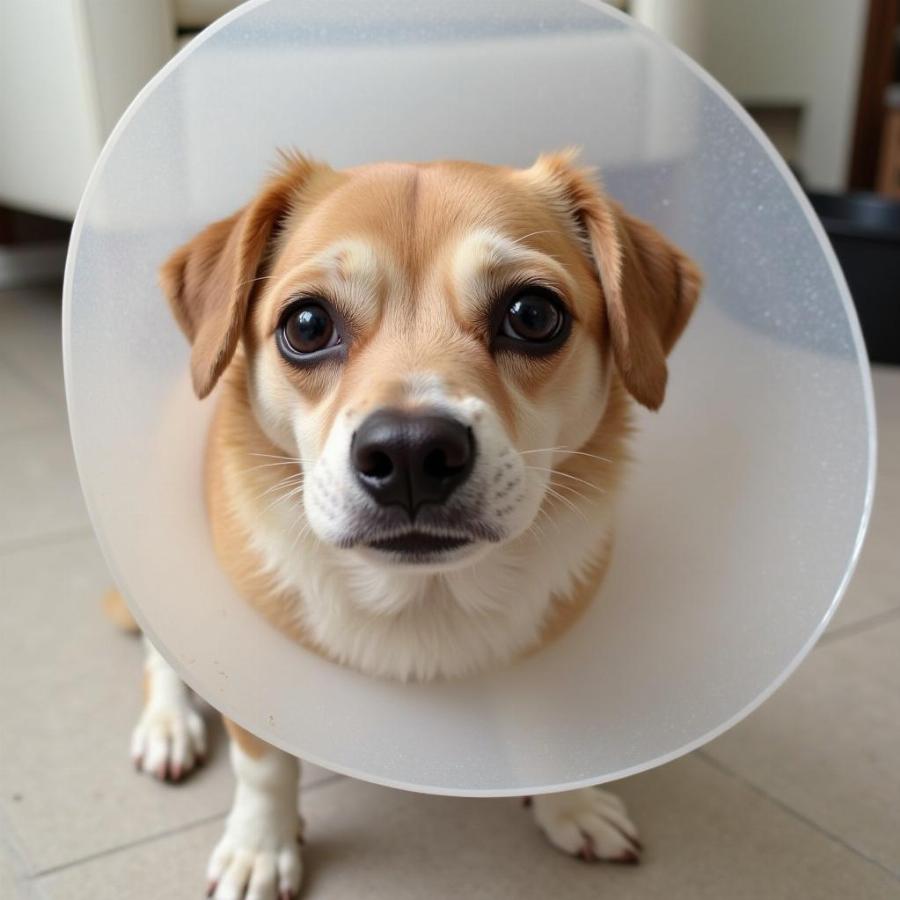Spaying your dog is a responsible decision, and ensuring a smooth recovery is paramount. One of the most common post-operative tools is the dreaded “cone of shame.” But how long to keep a cone on a dog after spay surgery? This is a crucial question for pet owners, as it directly impacts your dog’s comfort and healing process. We’ll delve into the specifics of cone usage, including factors influencing duration, alternatives, and tips for managing your furry friend during this time.
Understanding the Purpose of the Cone
The cone, also known as an Elizabethan collar, serves a critical purpose: preventing your dog from licking or biting the incision site. After spaying, the area is sensitive and prone to infection. Interfering with the wound can disrupt healing, leading to complications and potentially requiring further veterinary intervention. The cone acts as a physical barrier, ensuring your dog can’t reach the stitches. This is essential for a clean and uncomplicated recovery.
 Dog wearing a cone after spay surgery
Dog wearing a cone after spay surgery
Factors Affecting Cone Duration
While a general guideline is 10-14 days, the actual duration of cone wear varies depending on individual factors. Your veterinarian will provide the most accurate recommendation based on your dog’s specific case. Factors influencing cone duration include the complexity of the surgery, your dog’s healing rate, and their tendency to lick or chew. Some dogs heal faster than others, while some are more persistent in trying to reach their incision. Observe your dog’s behavior closely.
How to Tell if Your Dog Needs the Cone Longer
If your dog continuously tries to remove the cone or shows excessive interest in the incision even after the recommended period, it might be necessary to extend cone wear. Consult your veterinarian if you notice any signs of redness, swelling, discharge, or if your dog seems to be in pain. Early intervention is key to preventing infections and ensuring a smooth recovery. dog recovery suits are a comfortable alternative to the cone.
Alternatives to the Cone
Traditional cones can be cumbersome and uncomfortable for dogs. Luckily, there are alternatives available, such as inflatable collars, soft E-collars, and even dog operation suit. These options offer more comfort and flexibility while still effectively protecting the incision site. Discuss these alternatives with your veterinarian to determine the best fit for your dog’s size, breed, and personality.
Choosing the Right Alternative
When choosing a cone alternative, consider your dog’s size and activity level. An inflatable collar might be suitable for a calmer dog, while a more secure option like a dog recovery suits is better for active dogs prone to escaping from less restrictive alternatives.
Tips for Managing Cone Wear
Making cone wear more manageable is essential for both you and your dog. Adjust the cone’s fit to ensure it’s snug but not too tight. Pad the edges with soft material for added comfort. Supervise your dog while wearing the cone, especially during mealtimes and bathroom breaks. Provide plenty of positive reinforcement and treats to create a positive association with the cone.
FAQ: Common Questions about Cone Use After Spaying
- Q: Can my dog sleep with the cone on? A: Yes, most dogs adapt to sleeping with a cone.
- Q: How do I clean the cone? A: Wash it regularly with mild soap and water.
- Q: Can I take the cone off for short periods? A: Only under close supervision and if your dog doesn’t attempt to lick the incision.
- Q: My dog seems depressed while wearing the cone. What should I do? A: Extra love, attention, and playtime can help.
- Q: What if my dog manages to lick the incision despite the cone? A: Contact your veterinarian immediately.
- Q: Are there any signs of infection I should watch for? A: Redness, swelling, discharge, and excessive licking are potential signs.
- Q: When can I expect the spayed scars on dogs to fully heal? A: Typically within two weeks, but complete healing can take several months.
Conclusion
Knowing how long to keep a cone on a dog after spay is vital for a smooth recovery. While the general guideline is 10-14 days, factors like healing rate and individual behavior can influence the duration. Consulting with your veterinarian is crucial for personalized advice and monitoring. Alternatives to traditional cones are available for enhanced comfort, and proper management techniques can make the experience less stressful for your furry companion. Remember, patience and consistent care are key to ensuring your dog heals completely and comfortably. By following your veterinarian’s instructions and providing a supportive environment, you can help your dog navigate this post-operative period with ease.
Expert Insight from Dr. Emily Carter, DVM: “A comfortable recovery is just as important as the surgery itself. Don’t hesitate to explore cone alternatives or contact us if you have any concerns about your dog’s post-operative care.”
Expert Insight from Dr. Sarah Miller, DVM: “Observing your dog’s behavior is crucial. If they’re constantly trying to reach the incision, extending cone wear might be necessary, even if it seems inconvenient.”
Do you have other questions about your dog’s spay recovery? Explore these related topics:
Beaut Dogs is your trusted source for comprehensive and expert-driven information on all things dog-related, from breed-specific guides to essential care tips. We’re dedicated to empowering dog owners with the knowledge they need to provide the best possible care for their beloved companions. When in doubt, always contact us at Email: [email protected] for detailed and accurate advice from Beaut Dogs.